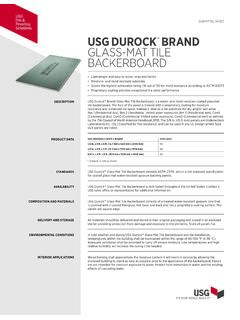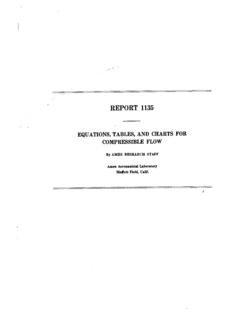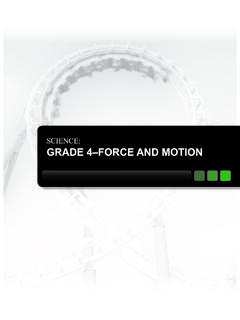Transcription of Photovoltaic (PV) Tutorial - MIT
1 Photovoltaic (PV). Tutorial This presentation was designed to provide Million Solar Roof partners, and others a background on PV and inverter technology. Many of these slides were produced at the Florida Solar Energy Center and PVUSA as part of training programs for contractors. Some Benefits of Solar Electricity !Energy independence !Environmentally friendly ! Fuel is already delivered free everywhere !Minimal maintenance !Maximum reliability !Reduce vulnerability to power loss !Systems are easily expanded Solar energy has more even distribution across the United States than other forms of renewables such as wind or hydro. Where wind and hydro are available, they are good sources of energy, but only select places get good wind, and hydro can have many impacts, whereas solar energy is spread out across the entire and has very little environmental impacts.
2 PV is very modular. You can install as small or as large a PV system as you need. Example: One can install a PV module on each classroom for lighting, put PV power at a gate to run the motorized gate-opener, put PV power on a light pole for street lighting, or put a PV system on a house or building and supply as much energy as wanted. You can start with a small budget this year, and add more modules and batteries later when you are more comfortable with solar, or when loads increase. New PV modules can be added at any time. Difference between PV and thermal Photovoltaic (photo = light; voltaic =. produces voltage) or PV systems convert light directly into electricity using semi- conductor technology. (@ 10% efficiency). thermal systems (hot water, pool heaters).
3 Produce heat from the sun's radiation (@ +40 % efficiency). Large difference in value of energy types. The important point of this slide is that it emphasizes that there is another type of solar energy, solar thermal , that converts sunlight energy into heat. This workbook does not cover solar thermal . We are not concerned about the heat content of sunlight, PV cells and modules do not utilize the heat, only the light. What Are Solar Cells? Thin wafers of silicon Similar to computer chips much bigger much cheaper! Silicon is abundant (sand). Non-toxic, safe Light carries energy into cell Cells convert sunlight energy into electric current- they do not store energy Sunlight is the fuel . The element Silicon is the second most abundant element on the earth's surface, next to Oxygen Silicon and Oxygen together make sand (Silicon Oxide, SiO2).
4 The Oxygen is removed at high temperatures, and leaves behind the Silicon So the basic material of solar cells is abundant and safe Emphasize that the cells are converters, not original sources of energy. They need the sunlight as their fuel just like conventional motor generators need fuel to work. But solar cell fuel is delivered for free all over the world. How Solar Cells Change Sunlight Into Electricity Light knocks loose electrons photon from silicon atoms internal Freed electrons have extra h+ field e- energy, or voltage . Internal electric field pushes electrons to front of cell e- Electric current flows on to other cells or to the load Cells never run out of P/N junction electrons This is intended to be a quick explanation of the basics of direct solar conversion ( the Photovoltaic effect ).
5 This picture looks at a cross-section of a PV cell. Light actually penetrates into the cell, it doesn't just bounce off the surface. Particles of light called photons bounce into negatively charged electrons around the silicon atoms of the cell, and knock these electrons free from their silicon atoms. The energy of the photon is transferred to the electron. There are over a billion billion photons falling on the cells every second, to there are lots of electrons knocked loose! Each electron is pushed by an internal electric field that has been created in the factory in each cell. The flow of electrons pushed out of the cell by this internal field is what we call the electric current . As long as there is light flowing into the cells, there are electrons flowing out of the cells.
6 The cells doesn't use up its electrons and loose power, like a battery. It is just a converter, changing one kind of energy (sunlight) into another (flowing electrons). For every electron that flows out the wire connected to the front of a cell, there is another electron flowing into the back from the other return wire. The cell is a part of a circuit . (Latin for go around ), where the same electrons just travel around the same path, getting energy from the sunlight and giving that energy to the load. Definitions: PV Cell Cell: The basic Photovoltaic device that is the building block for PV modules. All modules contain cells. Some cells are round or square, while thin film PV modules may have long narrow cells. Connect Cells To Make Modules One silicon solar cell produces volt 36 cells connected together have enough voltage to charge 12 volt batteries and run pumps and motors Module is the basic building block of systems Can connect modules together to get any power configuration Cells are too small to do much work.
7 They only produce about 1/2 volt, and we usually need to charge 12 volt batteries or run motors. A typical module has 36 cells connected in series, plus to minus, to increase the voltage. 36 times volt yields 18 volts. However, the voltage is reduced as these cells get hot in the sun and 12-volt batteries typically need about 14 volts for a charge, so the 36 cell module has become the standard of the solar battery charger industry. With connected cells and a tough front glass, a protective back surface and a frame, the module is now a useful building block for real-world systems. The cells make up the module, and the modules make the power array. If you need more than 12 volts, you can connect modules in series too. If you need more than the current from one module, you can connect modules in parallel.
8 Definitions: PV Module Module: A group of PV cells connected in series and/or parallel and encapsulated in an environmentally protective laminate. Siemens SP75. Solarex MSX60. 75 watt single crystal 60 watt polycrystalline The PV module is the smallest package that produces useful power. The process involved in manufacturing these modules requires high precision and quality control in order to produce a reliable product. It is very difficult, and therefore not practical, to make home- made modules. Definitions: Encapsulation Encapsulation: The method in which PV. cells are protected from the environment, typically laminated between a glass superstrate and EVA substrate. Newer light weight flexible laminates use a polymer superstrate and a thin aluminum or stainless steel substrate.
9 This is the most critical part of the module manufacturing process. It keeps out moisture and contaminants that cause PV modules to fail prematurely. Definitions: PV Panel Panel: A group of modules that is the basic building block of a PV array. Panel is a term used for a group of modules that can be packaged and pre-wired off-site. The size of the panel (or large modules) is often related to how much weight and size two workers can effectively handle on a roof surface, such as you see here. Definitions: PV Array Array: A group of panels that comprises the complete PV generating unit. This array is made up of 8 panels, consisting of 3 modules each, for a total of 24 modules in the array. If the PV system has more than one grouping of PV modules, we call each grouping a sub-array.
10 The total of all the sub-arrays is then called the complete PV array. Standoff-Mounted Arrays The standoff-mounted PV array is the most common type of residential roof-top installation. It is mounted above and parallel to the roof surface. It is located slightly above the roof for cooling purposes and is parallel to the roof for aesthetic purposes. Rack- and Pole-Mounted Arrays Two common methods of ground mounting PV systems are racks and poles. Some pole mounts may also have the ability to track the sun across the sky. The California Patio Cover Another method of ground-mounting is a patio cover. This provides shade to the patio area without taking up valuable yard space. It also provides an alternative to roof mounting. This is especially important in areas where concrete or tile roofs are common since it can be very difficult and costly to roof mount to tile roofs.

















